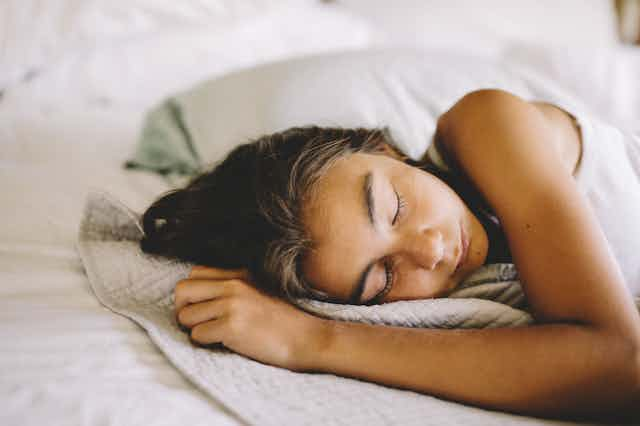Adolescence is a sensitive life stage when emerging independence, changing social roles, excessive screen time, academic pressures, and significant biological changes can lead to emotional and behavioural problems.
The current generation of teens is chronically sleep-deprived and, unfortunately, considered the most sleep-deprived group in human history.
In teenagers, irregular bedtimes, short sleep duration and poor sleep quality are commonly reported sleep issues. These problems can cause emotional regulation issues, risky behaviour and academic disengagement. In the longer term, poor sleep can lead to obesity, health conditions (including diabetes), mental health problems, and risk taking behaviour.
The issue of poor sleep and its impact on life outcomes needs particular attention for Aboriginal and Torres Strait Islander teenagers who experience disproportionately high rates of poor outcomes in health, social and emotional well-being and education.
Sleep vulnerability
The ongoing effects of colonisation, intergenerational trauma, and other social determinants of health increase the vulnerability of Aboriginal and Torres Strait Islander teenagers to poor sleep. While some poor sleep issues are transient, continued exposure to racism, discrimination, household overcrowding and lack of safe sleeping spaces lead to chronic sleep issues.
Sleep health data for Aboriginal and Torres Strait Islander peoples is limited. Still, some studies suggest one in three young Aboriginal and Torres Strait Islander people struggle with poor sleep, significantly higher than their non-Indigenous counterparts.
The impact of poor sleep on the life outcomes of Aboriginal and Torres Strait Islander young people is a major concern for community members, service providers and policymakers.
Despite this, services focused on sleep health promotion in Aboriginal and Torres Strait Islander communities are non-existent. This could be because although the need for healthy sleep is universal, the meaning of sleep health is shaped by cultural and societal factors. These include the acceptability of co-sleeping, living in multi-family housing or the role of dreaming.
Mainstream programs that don’t draw together the principles of health and cultural knowledge offer limited effectiveness for sleep health promotion in Aboriginal and Torres Strait Islander communities. But a new program could change that.
A co-designed approach
In response to community needs, Australia’s first sleep health program for Aboriginal and Torres Strait Islander teenagers – Let’s Yarn About Sleep – was co-designed in Mount Isa, Queensland.
Community members were vocal about wanting to harness the potential of sleep as part of efforts to improve health outcomes, reduce teenage contact with the criminal justice system and improve academic engagement. Community yarns also identified the need to strengthen local sleep health service delivery and train Aboriginal and Torres Strait Islander people as “sleep coaches”.
The co-design and evaluation of the program involved consultations with more than 200 community members, integrating Traditional and Western knowledge on sleep health and offering ideas for improving sleep.
The ten-week program includes data collection before and after delivery, including questionnaires, sleep diaries and actigraphy (a non-invasive method of monitoring human rest and activity cycles).
Read more: Drinking fountains in every town won't fix all our water issues – but it's a healthy start
What the program involves
The program empowers young people to identify their sleep health goals and work with coaches to achieve them. At the beginning of the program, participants identify a group and an individual goal they would like to attain.
The group goal focuses on making sleep health a priority. For example, group members agreeing not to use their phones after 10pm. Individual goals are focused on reponses to personal circumstances. So, individual goals included de-cluttering or going to bed at least 30 minutes earlier.
While the program’s key focus is to improve participants’ knowledge, understanding and awareness of sleep health, one of the key objectives is to support participants in developing sustainable sleep hygiene practices (healthy habits for a good night’s sleep). During the program, participants learn about sleep hygiene practices such as following a consistent bedtime, reducing screen time and practising Indigenous relaxation training before bedtime.
The program has also led to the training of two Aboriginal and Torres Strait Islander people as Australia’s first Indigenous sleep coaches. Clinical staff at the local Aboriginal Community Controlled Health Organisation and hospital have since expressed interest in gaining these skills.
Read more: To reduce harm from alcohol, we need Indigenous-led responses
What happened as a result of improved sleep
So far, 35 teenagers in the community have been enrolled in the program and 13 have graduated. The program has also been integrated into the Emerging Leaders program at the local high school.
The program data shows the majority of the program participants were staying up until very late at the night. However, participants achieved their self-identified goals and believe this program gave them tools to improve their sleep. The program has received support from community Elders, parents and carers, service providers and young people.
The project team and community members are working to co-design a sleep health program for adults and extend the youth sleep program to other communities.
Roslyn Von Senden, a Kalkadoon woman from Mount Isa, who is training to become a sleep coach, reflected on the cultural importance of the program.
Dreams are an important part of our life, a medium to connect with our ancestors to be guided, foresee things, connect with others, and get inspiration and ideas to express our artistic talent. Sleep loss deprives us of opportunities to connect with our culture, ancestors, and who we are as traditional custodians of the world’s oldest surviving culture.
While the initial program was funded through the Medical Research Future Fund and focused on Mount Isa, additional funding from the National Health and Medical Research Council and industry partner Beyond Blue supports the program in other remote communities.
The resulting community-led sleep health movement aims to leverage the untapped potential of sleep health in improving academic and sporting performance, reducing crime, improving health outcomes and empowering Aboriginal and Torres Strait Islander young people.

